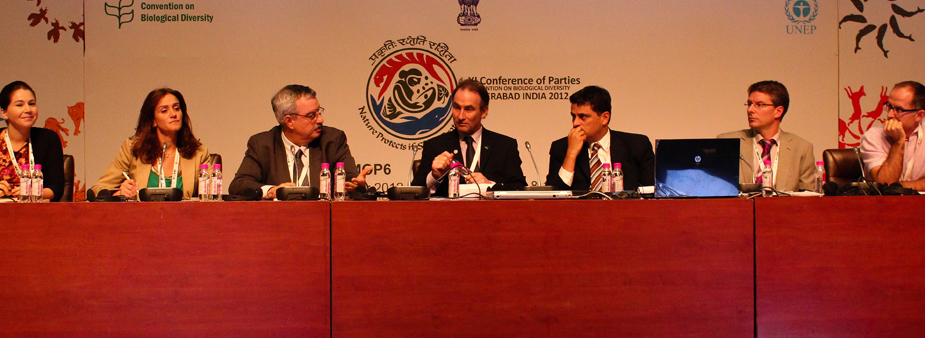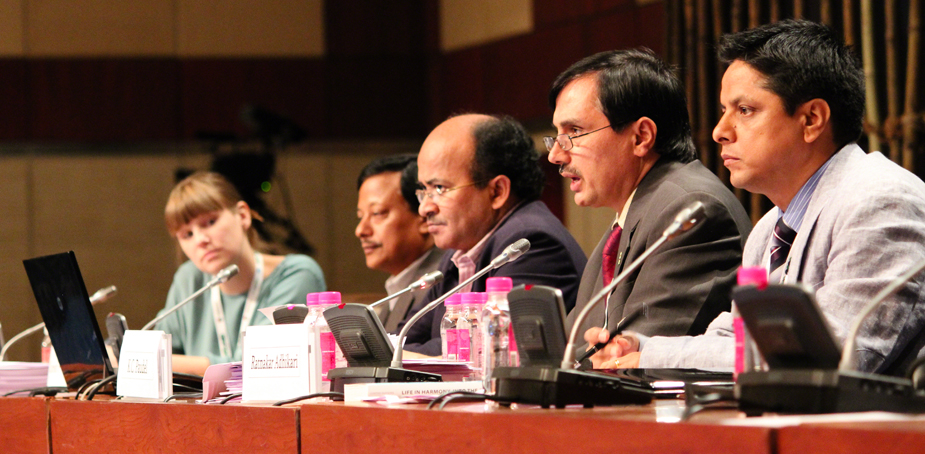|
|

Braulio Dias, Executive Secretary, SCBD, opened the event with a brief analysis of challenges earlier NBSAPs faced, such as lack of compliance and limited cross-sectoral mainstreaming. Dias underscored that the next generation of NBSAPs should be strategic implementation instruments that are adopted as national policies. He stressed that the NBSAP Forum would play a crucial role in providing support to the NBSAP revision process, and urged partners to join the partnership.
Jessica Smith, UNEP-WCMC, explained that the NBSAP Forum is envisioned to be a community of practice that will provide easy to access and targeted technical resources such as: case studies; peer and expert reviews; e-learning modules; and practical guidelines. She observed that the goal was to enable diverse actors to come together online and in person to share knowledge, experiences, and resources.
Mark Zimsky, GEF, discussed the importance of revising NBSAPs to be strategic instruments focused on addressing the drivers of biodiversity loss rather than project wish-lists. He reported that 111 countries have been approved, and have accessed GEF funds to revise their NBSAPs.
Nik Sekhran, UNDP, highlighted that the forum would support countries in linking NBSAPs to national development policy and financing frameworks. He noted that this would be done through support mechanisms such as: online webinars; a consultants roster; sub-regional learning groups; a help desk function for queries; centres of excellence supporting NBSAPs; and direct technical assistance through implementing agencies and the GEF.
Neville Ash, UNEP, discussed UNEPs work through regional offices on NBSAPs, including valuation of ecosystems services, cross-sectoral mainstreaming, and national indicators. He reported that UNEP was collaborating with partners to raise funds for the partnership.
David Duthie, SCBD, reviewed the technical support SCBD is providing to parties on NBSAPs and national targets, through capacity-development workshops and initiatives focused on legal preparedness and biodiversity mainstreaming.
During the question and answer session, participants highlighted the importance of securing political will, transforming NBSAPs into legal instruments, and integrating biodiversity into national budgets. |
 |
 |
 |
 |
 |
L-R: Jessica Smith, UNEP-WCMC, Diane Klaimi, UNEP-ROWA, Braulio Dias, SCBD, David Duthie, SCBD, Nik Sekhran, UNDP, Neville Ash, UNEP, and Mark Zimsky, GEF.
|
|
 |
 |
 |
 |
Ratnakar Adhikari, SAWTEE, noted that only a handful of multinational companies control the global supply of seeds and they promote the use of proprietary seeds. He observed that the increasing monoculture is also making farmers vulnerable to climate change. Adhikari called for a robust ABS mechanism with incentives for rewarding farmers for breeding new seed varieties.
Krishna Paudel, Ministry of Forests, Nepal, observed that climate change is expected to result in a substantial reduction in food production and that some wild crop varieties could soon become extinct. He called for: promoting the importance of traditional seed systems, particularly to the scientific community; encouraging local communities to maintain, share and use traditional agricultural seeds and breeds; developing new climate change resistant and resilient seed varieties; engaging the private sector in biodiversity conservation; and encouraging the diversification of food crops in farming systems.
Suresh Singh, Centre for International Trade, Economics & Environment (CUTS) International, emphasized the need to understand impacts at the local level and implement useful adaptive practices. He highlighted a study conducted in conjunction with Oxfam novib aimed at understanding marginal farmers’ perceptions on climate change impacts and ascertaining measures to ensure sustainable livelihoods. He said perceptions on adaptive steps by farmers included: switching to climate resilient agriculture and crops; and replacing water intensive crops.
Pratap Shrestha, USC Canada Asia, noted that from the fourth Intergovernmental Panel on Climate Change, 10-12% of greenhouse gas emissions are largely derived from modern agricultural production and distribution systems, mono cropping and high external inputs. He drew attention to the lack of a specific COP-11 agenda item on agricultural biodiversity and the narrow focus on mitigation under UNFCCC with limited attention on agricultural biodiversity.
Ane Jørem, Fridtjof Nansens Institute, highlighted her institution’s work on conditions for the successful implementation of certain international agreements, which examines implementation of the CBD and IPTGRFA, in India and Nepal and also considers prospects for further implementation. She noted the work that India has done on implementing polices for the sustainable management of crops and described Nepal as a country endowed with a rich heritage of plant genetic resources being impacted by climate change. |
 |
 |
 |
 |
 |
L-R: Ane Jørem, Fridtjof Nansens Institute, Pratap Shrestha, USC Canada Asia, Suresh Singh, CUTS International, Krishna Paudel, Ministry of Forests, Nepal, and Ratnakar Adhikari, SAWTEE
|
|
 |
 |
 |
 |
This side event was moderated by Bert Lenten, CMS, and addressed ecological networks and shared case studies on integrating the concept into the design of protected areas (PAs) and on building strategic alliances internationally to identify critical sites and coordinate conservation efforts.
Laura Cerasi, CMS, introduced the concept of ecological networks, and summarized the work of CMS in this area. She explained that ecological networks promote connectivity between biodiversity hotspots and habitats used by species through corridors and stepping stones. Providing concrete examples from migrations of birds, mammals, and aquatic species, she highlighted priorities for ecological networks, including: conserving critical sites along major migration routes; restoring threatened habitats; creating incentives to reduce unsustainable use of species; and conducting environmental impact assessments and strategic environmental assessments for infrastructure projects that impact on migratory species.
On the way forward, Cerasi stressed that the first step will be to map critical sites along migration routes. She also summarized CMS Resolution 10.3 on ecological networks, which calls on parties to cooperate and share information on ecological networks. She noted that the resolution requests the CMS Scientific Council to conduct a strategic review of PA systems and initiatives aimed at promoting ecological networks to address the needs of migratory species throughout their migratory ranges.
Lajla Tunaal White, Norway, noted that the Norwegian government has provided funding to CMS to improve understanding of networks and key sites in order to replicate lessons and best practices. She offered two examples: White Earned Kob conservation in South Sudan, where there are efforts to strengthen cross-boundary cooperation and engage the agriculture sector and local communities; and threatened Lesser White Fronted Goose, where the Norwegian government is strengthening cooperation with other countries along the birds migration route.
Pablo Manzano, IUCN, presented on migratory wildlife and pastrolism: a possible and necessary coexistence. He highlighted the role of mobile pastoralists, as custodians and protectors of wild migratory species routes, which helps to boost the ecological function of these routes. He also noted that livestock is important for ecosystem functions such as dispersal of insects and seeds, landscape shaping, fertilziation and disturbance.
|
|
 |
 |
 |
 |
 Please e-mail the
Digital Editor
should you have any questions regarding the content of this page
Please e-mail the
Digital Editor
should you have any questions regarding the content of this page |
 |
 |
 |
 |
|
|
|
|